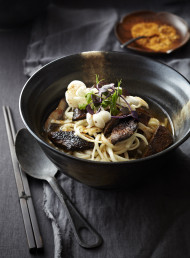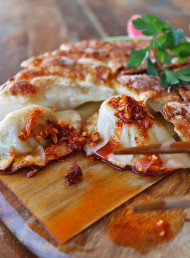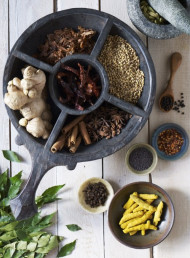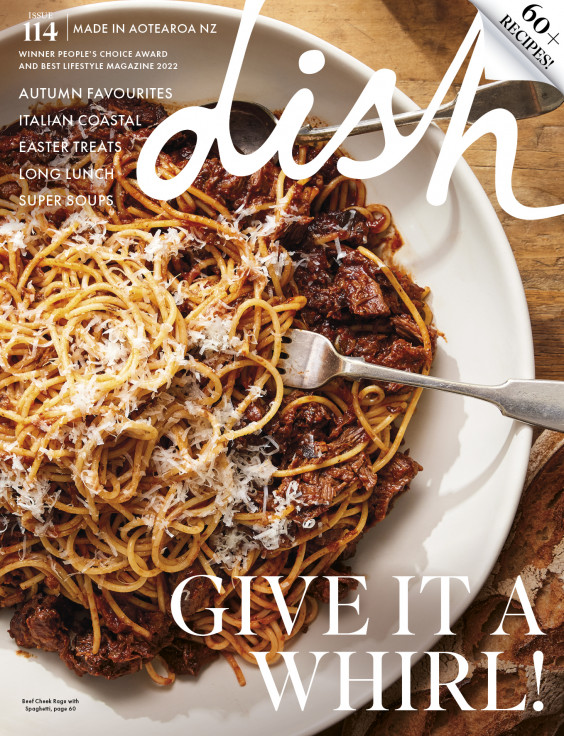Pantry essentials: Japanese
Photography by Sarah Tuck.
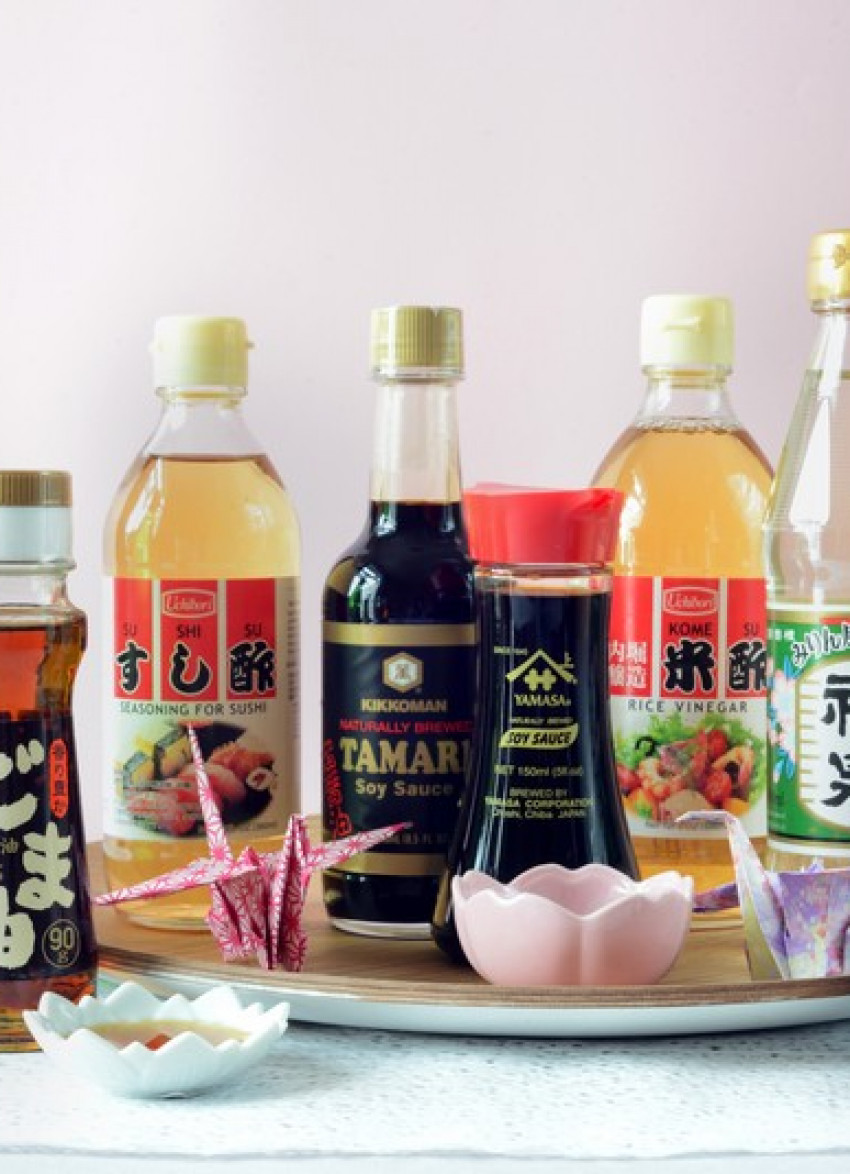
Many Japanese ingredients are readily available in the international section of supermarkets, but it’s worth seeking out a wider selection, particularly fresh, chilled and frozen products from your local Japanese or Asian food store.
SAUCES & CONDIMENTS
Dashi: made from kombu (dried kelp) and katsuobushi (bonito flakes), this provides the all important umami or ‘fifth taste’ to Japanese cooking. Dashi forms the basis of noodle broths, chawan mushi (steamed savoury egg custard), hotpots, soups, dressings and sauces.
Dashi stock powder is readily available and provides instant stock.
Japanese pickles: aubergine, cucumber, daikon radish and ginger are typically pickled and served alongside a meal, be it breakfast, lunch or dinner. These vegetables are usually brined to retain their crunchy texture, before sweet vinegar is added. Sometimes red vinegar from umeboshi plums is used.
Kewpie mayonnaise: ubiquitous to Japanese fast foods and very much part of modern Japanese cuisine, from California sushi rolls to octopus balls and Okonomi-yaki (savoury cabbage pancakes with meat or seafood). The Kewpie brand with its distinctive Kewpie baby logo on the
wrapper was the first Japanese mayonnaise in a jar when launched in 1925. You can use your favourite mayo, but for that uniquely Japanese mayonnaise taste, try Kewpie.
Mirin: a sweet sake condiment made from rice and distilled alcohol. It is mildly sweet and used to add flavour and a glossy amber colour to grilled meats and fish.
Nanami/Shichimi togarashi: this chilli pepper seasoning is a blend of seven spices, usually consisting of two hot and five aromatics. In Japan some spice shops blend to order and offer a variety of house blends of dried spices which include hemp, poppy, black and white sesame and flax seeds; with the addition of green seaweed flakes, red and green shiso, shiso seeds, ginger, yuzu or orange peel, hot Chinese pepper and sansho pepper. Sprinkle over tofu, noodle soups, vegetables, hotpots and tempura.
Rice vinegar: pure rice vinegar, junmaisu, is milder than either wine or cider vinegar and has a sweet aroma and mellow flavour. Look for pure fermented rice vinegar on the label. Genmaisu, brown rice vinegar, is also used as a condiment, for pickles and dressings.
Sake: the different grades of drinking sake are related to the amount of polishing the rice grains receive before fermentation. The more polished the rice, the purer the flavour. Buy sake in smaller bottles as it deteriorates quickly once opened, keep refrigerated and use within three months. Better grades of drinking sake used for cooking will offer better clarity of flavour. Cooking sake is pale straw in colour and brewed from glutinous rice and malted rice with added alcohol. Not usually consumed as a beverage.
Sake helps tenderise meats or fish and balances acidic flavours. It is used in combination with, or in place of mirin in dressing and sauces.
Sesame oil: pressed from toasted sesame seeds, use this fragrant, nutty oil sparingly as the flavour and aroma can dominate. A few drops added to dressings and marinades can enhance a dish with a full aroma and sesame taste. Store in a cool, dark pantry.
Sesame seeds: these are best toasted to bring out their nutty flavour and aroma. Black sesame is used for contrasting colour and shape, while white sesame seeds may be ground after toasting and used in dressings or condiments.
Soy sauce (shoyu): traditional Japanese soy sauce is lighter and less salty than Chinese soy sauce and made by fermenting soybeans, roasted wheat, salt and water. It is savoury and used to add saltiness and colour to sauces, marinades and braised dishes. Usukuchi shoyu is light soy with mild flavour and aroma but saltier due to the shorter fermentation; koikuchi shoyu, regular or dark soy is thicker and slightly sweeter with a more intense, complex flavour. Tamari, made with soy beans, rice, a small quantity of wheat (or none) and the longest fermentation time is dark in colour and more viscous with a rich flavour and sweet aroma.
Sushi rice vinegar: rice vinegar seasoned with sugar and salt used to flavour rice used for making sushi. It is normally mixed into the hot rice.
Umeboshi plums: plums pickled with salt and often red shiso added for colour. They are intensely salty and sour. Used as a snack, condiment and in dressings and sauces.
FRESH, DRIED & CHILLED
Daikon: these large white cylindrical radishes grow up to 8-10 cm in diameter and 40 cm long, with a mild mustard flavour and crisp texture. Choose radishes with firm smooth skin. Avoid any that are split or overly large as these can be woody and fibrous. Use grated into dressings, or in pickles, salads, broths, stir-fries and simmered red meat dishes.
Edamame beans: soybeans in the pod. These are available frozen and are generally pre-blanched and lightly salted. Cook from frozen in boiling water for 2-3 minutes before draining and serving in a bowl.
Fried tofu sheet or skins: deep fried thinly sliced tofu is generally available vacuum packed or frozen. Blanch quickly or place in a colander and rinse with boiling water, drain and pat excess oil from the tofu with a paper towel.
Gyoza wrappers: small round dumpling sheets made from wheat flour and water, used to wrap savoury meat, fish and vegetable fillings. The gyoza can be deep-fried, steamed or pan-fried.
Miso paste: made from fermented soy beans using rice, barley or soy koji (spores), salt and water. The salt content varies from 3-15 per cent. Each prefecture in Japan produces their own unique miso paste with variations in colour, flavour, texture and aroma. Used predominantly for flavouring soups, and in sauces for grilled fish, meat and vegetables. Sweet white miso, made using rice koji and a short fermentation, has a lower salt content. Ivory to pale beige in colour with a sweet, mellow flavour. White miso (non-sweet) is made using rice or barley koji with a longer fermentation. Red miso, made with soybean koji, has a high salt content and the longest fermentation. Amber in colour, it has the richest taste and aroma.
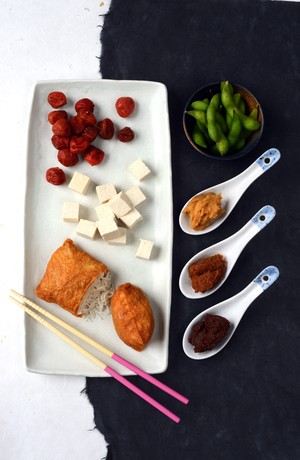
Noodles: an essential part of Japanese cooking. The following should all be cooked in boiling water until al dente, then refresh under cold water and drain well before serving. Soba are made from buckwheat flour, wheat flour, salt and water. Dried soba are sold in neat bundles each representing a single serving. Nutty in flavour, soba can be served hot with condiments and dashi broth or cold with a dipping sauce. Udon are thick cut wheat flour noodles with a slightly softer texture, but should still have some elasticity when cooked. Available fresh, frozen or dried or pre-cooked and vacuum packed. Serve in miso broths or with braised meats. Ramen are fresh or dried Chinese style noodles made from wheat flour dough. Use in stir-fries or soups.
Shiitake mushrooms: fresh shiitake are available in Asian foodstores and at some farmers’ markets. They have a meatier texture and more woodsy flavour than button or field mushrooms. The fresh caps are silkier when cooked than their dried counterparts, however the dried caps have a more robust flavour and the soaking liquid can be used to enhance stocks and sauces.
Soft tofu: fresh soft tofu is made from soy milk and has a smooth, delicate texture. Dried soybeans are soaked until soft and then blended to a mash. The mash is strained to separate the solids from the soy milk and a coagulant (calcium salt) is added to form the curd. The resulting curds are packed into wooden moulds lined with cloth. Once set they’re cut into blocks and sold packed in water. Kept chilled and covered in water, fresh soft tofu lasts 2-3 days and it’s best to refresh the water daily. Also available in sealed short-shelf life packs. The shelf life will vary from 2-3 weeks so check the “use-by” date.
Sushi rice: the principal variety of rice grown in Japan is short-grain rice. When cooked it has a soft, sticky texture perfect for sushi or rice balls. Wash the rice well with cold water before cooking to remove any residual starch from the milling process and to ensure separate grains of rice when cooked. For sushi rice, a dressing of rice vinegar, water, sugar, salt and kombu is mixed through the hot rice with a flat wooden paddle until incorporated. The rice is cooled before it is moulded into sushi.
Wasabi: fresh wasabi (Wasabia japonica) is a perennial crop. Although called Japanese horseradish, wasabi is not a root but a rhizome or swollen stem and belongs to the Cruciferae family. It can be cultivated in soil or water. Wasabi’s intense pungency and peppery flavour are due to volatile compounds released when it is macerated. Traditionally, fresh wasabi is prepared on a sharkskin grater to produce a fine paste. A popular condiment for sushi and nigiri sashimi, it is also used in dressings, stirred into mayonnaise, sauces and used to replace horseradish. Most pre-prepared wasabi paste is horseradish with a little wasabi added and green colouring. If you can’t find real paste, powdered wasabi can be mixed to a paste with a little filtered water. Fresh wasabi is grown commercially in Canterbury and the paste is available under the Pure Wasabi brand.
latest issue:
Issue #114
Autumn has arrived, and with it, the latest issue of dish, jam-packed with recipes that will have you fizzing to get in the kitchen! With a long Easter lunch featuring perfectly pink, blushing roast leg of lamb and wildly decadent baked mashed potatoes with caramelised onions, to simply scrumptious chocolate treats and sensational seasonal baking this issue has you covered - we reckon the Hot Cross Buns are our best yet! Salads make way for soothing soups, pies, puddings and our cover star beef cheek ragù with spaghetti – a must-make dinner for family and friends. With over 60 recipes in our latest issue there’s plenty of inspiration to keep you busy – and well-fed! Don’t forget to share your dish dishes with our Facebook community.

